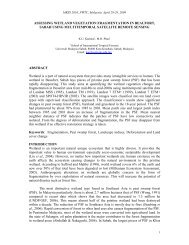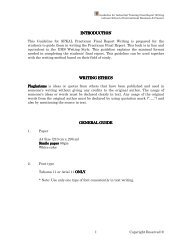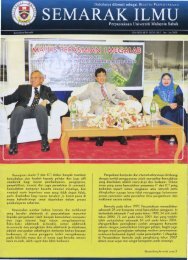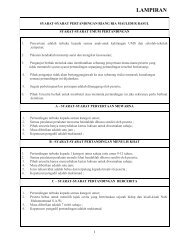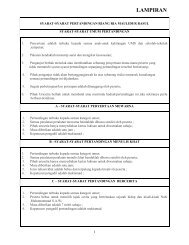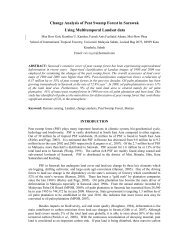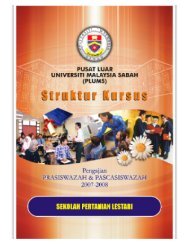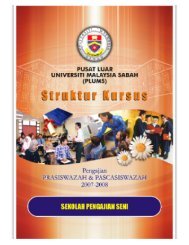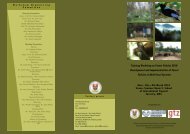Report for the German Agency for Technical Cooperation (GTZ) - UMS
Report for the German Agency for Technical Cooperation (GTZ) - UMS
Report for the German Agency for Technical Cooperation (GTZ) - UMS
Create successful ePaper yourself
Turn your PDF publications into a flip-book with our unique Google optimized e-Paper software.
O<strong>the</strong>r REDD programs<br />
• World Bank Forest Scheme. The bank’s <strong>for</strong>est carbon partnership facility aims to ga<strong>the</strong>r<br />
$300 million in contributions from rich nations to help at least a dozen developing<br />
countries, such as Vietnam, Costa Rica and Madagascar, prepare <strong>for</strong> Redd schemes. The<br />
programme aims to help nations figure out credible estimates of <strong>the</strong>ir national <strong>for</strong>est<br />
carbon stocks as well as offer technical aid to design individual Redd projects.<br />
• UN-Redd Programme. The UN is running a separate Redd programme to help developing<br />
nations get ready <strong>for</strong> <strong>the</strong> scheme. So far, $35 million has been committed.<br />
A FAO-Global <strong>Report</strong> available in <strong>the</strong> internet about <strong>for</strong>est resource assessment and<br />
recalculation of land cover (in Bahasa Indonesia at www.dephut.go.id). According to BMG<br />
<strong>the</strong> Indonesian Science Institute LIPI in Jakarta could be ano<strong>the</strong>r address <strong>for</strong> inquiries about<br />
ongoing projects. Projects conducted by <strong>the</strong> partners are amongst o<strong>the</strong>rs from Mr. Sadely<br />
UnMul about Acacia stands in coal mining areas, from Dr. Syahrinudin UnMul about carbon<br />
stock below ground in <strong>for</strong>est plantations at Sabulu 60 km from Samarinda. He works toge<strong>the</strong>r<br />
with Dr. Dady Ruhiyat, Soil Forest Laboratory.<br />
8. Available data<br />
This chapter deals with data and in<strong>for</strong>mation available from <strong>the</strong> prospective partners of <strong>the</strong><br />
project. This includes also departments like <strong>the</strong> National Coordinating <strong>Agency</strong> <strong>for</strong> Surveys<br />
and Mapping Indonesia, Ministry of Forestry Indonesia, Meteorological and Geophysical<br />
<strong>Agency</strong> Indonesia, The National Institute of Aeronautics and Space Indonesia, or <strong>the</strong><br />
Malaysia Meteorological Department. The Indonesian contacts as public utilities are not<br />
permitted to sell data but to exchange <strong>the</strong>m.<br />
8.1. Forest Inventories and vegetation data<br />
For <strong>the</strong> purpose of <strong>the</strong> project it is crucial to maintain <strong>for</strong>est inventory data from local sources<br />
because it might be too expensive and time-consuming to collect <strong>the</strong>m during <strong>the</strong> working<br />
phase. CIFOR underlined <strong>the</strong> possibility to receive such data from sources like <strong>the</strong> Ministry of<br />
<strong>for</strong>estry Indonesia, diverse timber companies (cooperation with CIFOR), <strong>the</strong> Project by <strong>the</strong><br />
Kreditanstalt für Wiederaufbau (see below), and o<strong>the</strong>r sources. The Ministry of Forestry<br />
Indonesia BAPLAN uses <strong>for</strong> <strong>for</strong>est inventory a grid of 20 x 20 kilometer with a single plot<br />
(“kluster”) of 100 x 100 m (divided in 16 subplots of 25 x 25 m). In Borneo 465 of <strong>the</strong>se<br />
klusters are found whereas <strong>the</strong> plots are both temporarily and permanent. The inventories at<br />
BAPLAN contain topography, height and diameter of trees, kind of species, seedlings,<br />
saplings, canopy cover, disturbance of <strong>the</strong> canopy, and soil. So far <strong>the</strong>y use 23 classes of<br />
land cover and 6-7 types of <strong>for</strong>est. According to IPCC <strong>the</strong>re shall be six classes at all in <strong>the</strong><br />
near future. BAPLAN basically agreed to share <strong>the</strong>ir <strong>for</strong>est inventory data with members of<br />
<strong>the</strong> project under certain conditions. UnMul can provide data about fast growing species from<br />
plantations taken <strong>for</strong> three years every September in Bukit Suharto. These data contain tree<br />
high, diameter, saplings, etc. and are still not published. They have photosyn<strong>the</strong>sis<br />
measurements as well. Surin Suksuwan from WWF in Kuala Lumpur recommended to ask<br />
<strong>the</strong> Sabah Forestry Department in Sandakan (<strong>for</strong> Sabah) respective in Kuching (<strong>for</strong> Sarawak)<br />
<strong>for</strong> <strong>for</strong>est inventory data. The UnMul Faculty of Forestry has a research <strong>for</strong>est between<br />
Balikpapan and Samarinda, <strong>the</strong> Bukit Suharto (ca. 20,000 ha), ano<strong>the</strong>r one is close to<br />
Samarinda.<br />
8.1.1. Forest types<br />
Several distinct ecosystems are found across Borneo as well as different types of <strong>for</strong>ests.<br />
The partners should agree upon <strong>the</strong> classification and definition of <strong>for</strong>est types early to<br />
16



